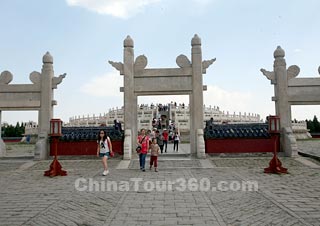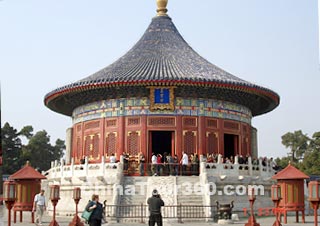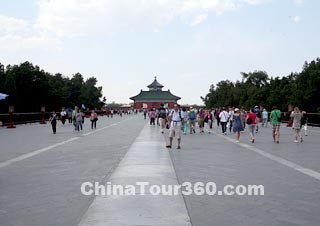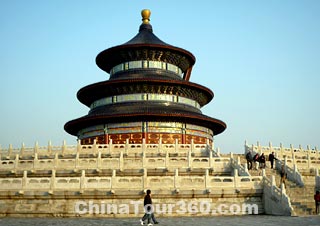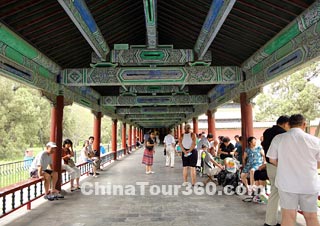Self-guided Temple of Heaven Tour
"Construction Axis of Temple of Heaven"
- Code: TH01
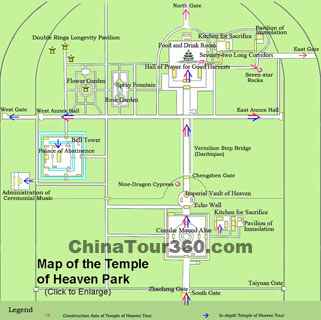 |
| Temple of Heaven Map |
The Temple of Heaven is divided by two enclosed long walls into inner part and outer part. The inner part is mainly composed by two clusters of buildings, the Circular Mound Altar in the south and the Hall of Prayer for Good Harvests in the north, which are connected by the Vermilion Steps Bridge (Danbiqiao), and these buildings form the construction axis of the Temple of Heaven. Taking this axis as the base, the Seventy-two Long Corridors and the Seven-star Rocks were built in the east, one Kitchen for Sacrifice was built in both south and north and the Palace of Abstinence was built in the west. Except for the Administration of Ceremonial Music, the outer part of the temple is densely wooded by various trees. With its northern part semicircular and the southern part square, the layout of Temple of Heaven embodies the dome-like heaven embraces the vast earth, namely the Hemispherical Dome Cosmology. If you would like to explore more wonders of the Temple of Heaven in limited time, the following recommended route along the construction axis will help you have an easy trip.
After entering from South Gate (Zhaoheng Gate), you will see two Enclosed Walls of the Circular, both of which consist of four groups of Ling Xing Gate with each including three doors and totals 24 doors. You may notice that the doors are of unequal size. It was said that the middle door was exclusively used by the God of heaven, while the doors on left side and on right side were separately used by the emperor and courtiers.
The Circular Mound Altar, which has three terraces with white marble, is right inside the walls. Here the emperors during the Ming and Qing dynasties offered sacrifice to God of heaven on the day of every Winter Solstice for worship. The Circular Mound Altar in the Temple of Heaven was first built in 1530 of the Ming Dynasty and extended in 1749 to its present scale during the reign of Emperor Qianlong in the Qing Dynasty. Legend has it that a child prodigy helped the extension of the Circular Mound Altar. Emperor Qianlong demanded all the stones used to the extension should be nine ('jiŭ' in Chinese Pinyin. It is a lucky number that symbolizes harmony and also a homophone of the Chinese character "久" with the meaning of long-lasting.) or the multiple of nine, and the craftsmen had to hand in a new design drawing within 3 days. The request put all the skilled craftsmen into a difficult situation, as the deadline was about to come, they still found no way out. Just at that time, a ragged boy begged for food and craftsmen treated him to all nice food they have. After eating to his fill, the young boy torn off the edge of his robe, wiped his mouth with it, threw the rag away and then went off. Thinking of the boy's weird behavior, the craftsman picked up the rag of the robe and found out a design drawing on it, which perfectly met the request of Emperor Qianlong.
|
|
Here is some of the construction data of the Circular Mound Altar related to the number of 9. The third terrace has a diameter of 9 Zhang (Zhang is a traditional Chinese unit of length and 3 Zhang equals to 10 meters.), and the total diameter of the three layered terraces adds up to 45 Zhang. From the ground terrace to the third terrace, there are respectively 180, 108 and 72 caved balustrades and all of them add up to 360. The famous Tianxin Stone (a round stone) at the center of the third terrace is surrounded by 9 rings of concentric flagstones, and the numbers of flagstones are increased by multiple of 9 from the first ring to the ninth rings, namely from 9 up to 81. Both the second terrace and ground terrace also have 9 rings of concentric flagstones, which are continuously increased by multiple of 9. The three terraces totally have 3402 flagstones, which just equals to 378 multiply 9.
Why Tianxin Stone is famous? Not only because the emperor used to stand on this stone to make prayer, but also for its fantastic effect that making one's voice clearer and louder.
In the east of Circular Mound Altar, you can visit the Kitchen for Sacrifice, where the sacrifices were handled before the day of Winter Solstice. Being one of the last preserved few Kitchens for Sacrifices in China, the building looks still very serious and tidy.
After the short visit to the Kitchen for Sacrifice, you can get back to the north Ling Xing Gate of the Circular Mound Altar and move forward along the construction axis of the Temple of Heaven. In a few minutes' walking, you will arrive at the Echo Wall that is famous for its acoustical phenomenon. If one whispers to the Echo Wall, the other could hear every word even though there is 40 to 50 meters away from each other.
Entering to the Gate of Glazed Tiles (Liuli Gate), an entrance in the Echo Wall, the buildings are the Imperial Vault of Heaven and its two Annex Halls. The Imperial Vault of Heaven was said to be the earthly dwelling of Heaven, so it was not traditionally named for hall or palace. A shrine for the Heaven is set in the middle and tablets dedicated to the ancestors of the Qing emperors were set in due order on both sides inside the Imperial Vault of Heaven. The two Annex Halls in the courtyard are dedicated to the deities of the Sun, Moon, Stars, Cloud, Rain, Wind and Thunder. Aside from the above architecture, the Triple-Sound Stone which is in the aisles that south to the steps of Imperial Vault of Heaven, wins great reputation also for its acoustical phenomenon. It is very interesting if you stand on the first stone of it and clap your hands, you will hear the echo once, while on the second stone and third stone, the echo will be heard two and three times.
|
|
Trees are standing at intervals around the Echo Wall. You are advised not to miss the Nine-Dragon Cypress, which has a history of over 590 years, in the west of the Wall. The trunk of this cypress is permeated with longitudinally deep furrows that ascending as if nine dragons are spiraling up, hence the name of Nine-Dragon Cypress.
You will soon arrive at the Chengzhen Gate by continuous strolling along the construction axis northward. Chengzhen Gate stands right at the division between the Circular Mound Altar and the Hall of Prayer for Good Harvests. Stepped inside Chengzhen Gate, you could find the Vermilion Steps Bridge (Danbiqiao) just lies at your feet.
Having a length of 360 meters and a width of 29.4 meters and ascending gradually by southing north, the Vermilion Steps Bridge (Danbiqiao) of the Temple of Heaven has affluent contents and rich meaning. It symbolizes one will move up to higher positions on one hand and need to go step by step along this tough route on the other hand. The Vermilion Steps Bridge is composed of three paths, which are different in both width and color. Compared with the two paths in the east and west, the path in the middle laid with white stones is a little higher and wider. This quite different path was branded as a sacred way for heaven, while the east path was for emperor and the west was for princes and courtiers to walk on. One may ask why it is called bridge as it doesn't look like so. In fact, the Vermilion Steps Bridge is 4 meters above the ground and there is an east-west passage underneath it to connect the Department for Sacrifices and the Slaughterhouse. This passage is also called 'the Ghost Pass', since it was used for the sacrifices like live sheep and ox to get through and to be slaughtered no more than half day at the slaughterhouse.
At the north end of Vermilion Steps Bridge, the other set of majestic and stately buildings of the Temple of Heaven come into your sight, among which the Hall of Prayer for Good Harvest (main hall) with its two Annex Halls is the most striking one. Before getting to the Hall of Prayer for Good Harvest, you can have a visit to the two Annex Halls of it. The East Annex Hall focuses on history and culture exhibition of the main hall and you will find the winning trail of it via the various exhibitions. The west Annex Hall shows the rites of offering sacrifices to heaven in ancient China with particular attention to that in the Qing Dynasty.
Built on a 6 meter high triple-tiered round terrace that is encircled by marble balusters, the Hall of Prayer for Good Harvest is an umbrella-like structure with three layers of eves and a gild ball on the top. Without having a single girder and purline, the hall only has 28 wooden posts, some laths and rafters locked into each other to support the roof from the inside. These wooden posts have some symbolic meanings as follows: the 4 wooden posts in the inner circle stand for the four seasons; the 12 posts in the middle circle represent the twelve months of a year; the 12 posts in the outer circle symbolize the twelve Shichen (Shichen is a measure of time in ancient and one Shichen equals to two hours.). A round marble slab with natural texture looks like dragon and phoenix designs in the middle of the stone-paved floor together with the paintings and gildings on the posts add splendors to the grand hall.
|
|
If you feel rather tired at this point, you can exit from the North Gate and finish the Temple of Heaven tour. However, if you are energetic enough and have extra time, you may move on to the Seventy-two Long Corridors and the Seven-star Rocks in the east of the Hall of Prayer for Good Harvest.
The Seventy-two Long Corridors is 5 meters wide and 350 meters long comprising 72 sections. Being served as the passage for sacrifices and other tributes, the corridors connect the Hall of Prayer for Good Harvest, the Kitchen for Sacrifice and the Slaughterhouse. Nowadays, the corridors are a perfect place for short rest and relaxation, where you can see many retired local people playing chess and musical instruments for amusement.
With a history of more than 470 years, the Seven-star Rocks are located at the southeast of the Seventy-two Long Corridors. You will probably find there are eight rocks instead of seven rocks as its name implies, why is this? It was said that the seven bigger rocks that line up by the position of the Seven Stars (the Big Dipper) were placed in the Ming Dynasty and the smallest one was put there in the Qing Dynasty. There have been two versions of the reason for the seven rocks were placed here. One goes that the Emperor Yongle in the Ming Dynasty attempted to find a treasure land for sacrificing heaven when moving the capital to Beijing. The gate of heaven opened one night and the Seven Stars fallen in, so Emperor Yongle ordained to build the altar on the spot. Another saying is that when Emperor Jiajing ruled in the Ming Dynasty, the Taoist priests advocated the open space southeast of the Hall of Prayer for Good Harvest was bad for firming the throne, so Emperor Jiajing gave the order to put seven rocks there to hold Feng Shui. As for the eighth rock, it was added in by followed Qing Emperor with the purpose of commemorating the merits of their ancestor, the Manchu eight banners.
Now your Temple of Heaven tour draws to a close, and you can exit from the East Gate of the Temple of Heaven. In addition, visitors could also take this suggested itinerary in reverse order by taking the East Gate or North Gate as the entrance and the South Gate as the exit.
- More Self-guided Summer Palace Tours:
- In-depth Temple of Heaven Journey
- Beijing Tours including the visit to Temple of Heaven:
- Capital Beijing Travel: 4-Day Beijing
- China Highlights: 9-Day Beijing - Xian - Shanghai
- Beijing Impression: 5-Day Small Group Beijing Tour
-
Hi, I will be visiting temple of heaven thru line 5 tiantangtongmen station East gate. What gate will I exit to end my temple of heaven tour. Is their nearby subway station at south gate? Ty
Asked By kambalah (Philippines) | Feb. 15, 2015 02:421 AnswerAnswer Question



